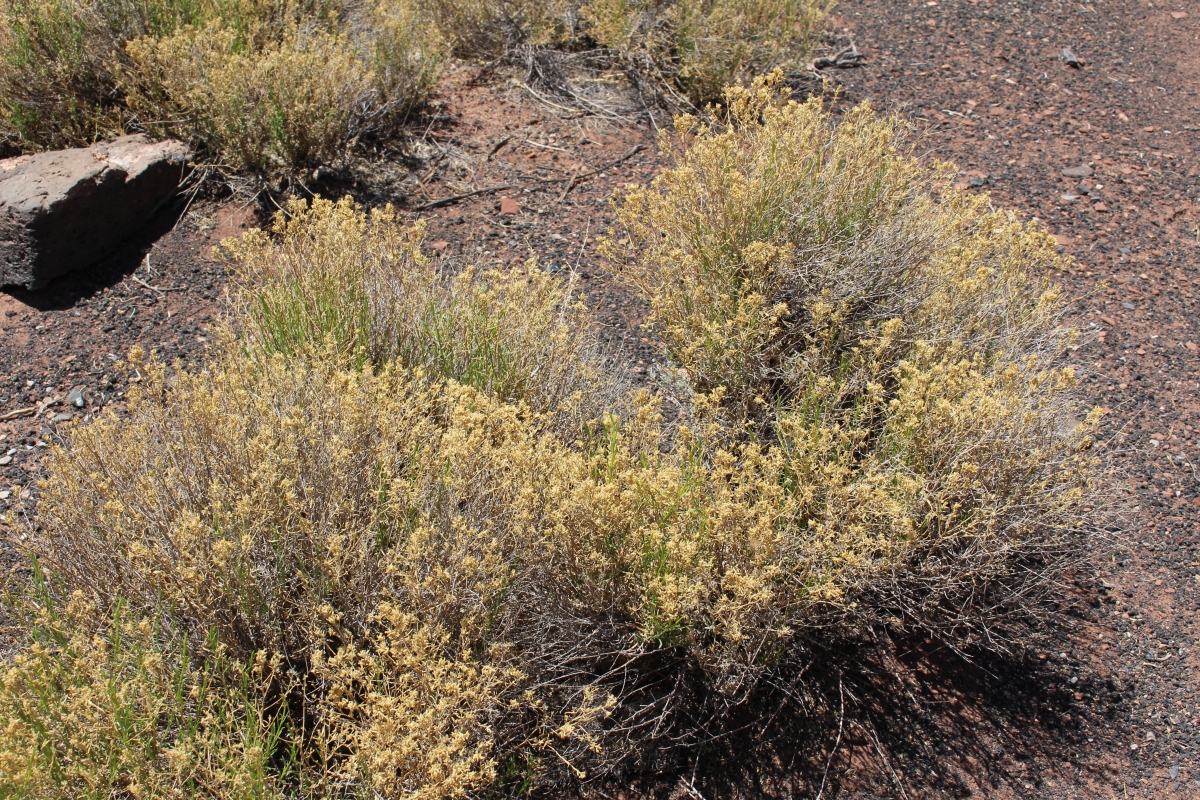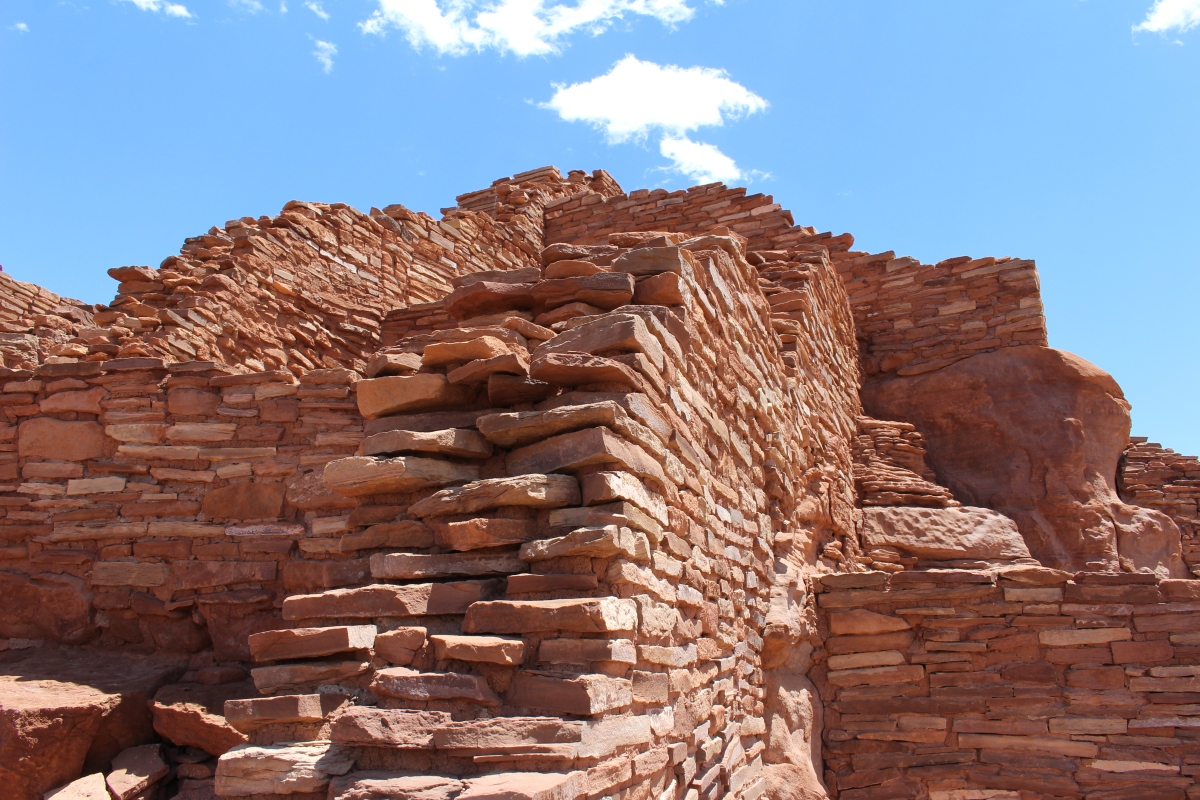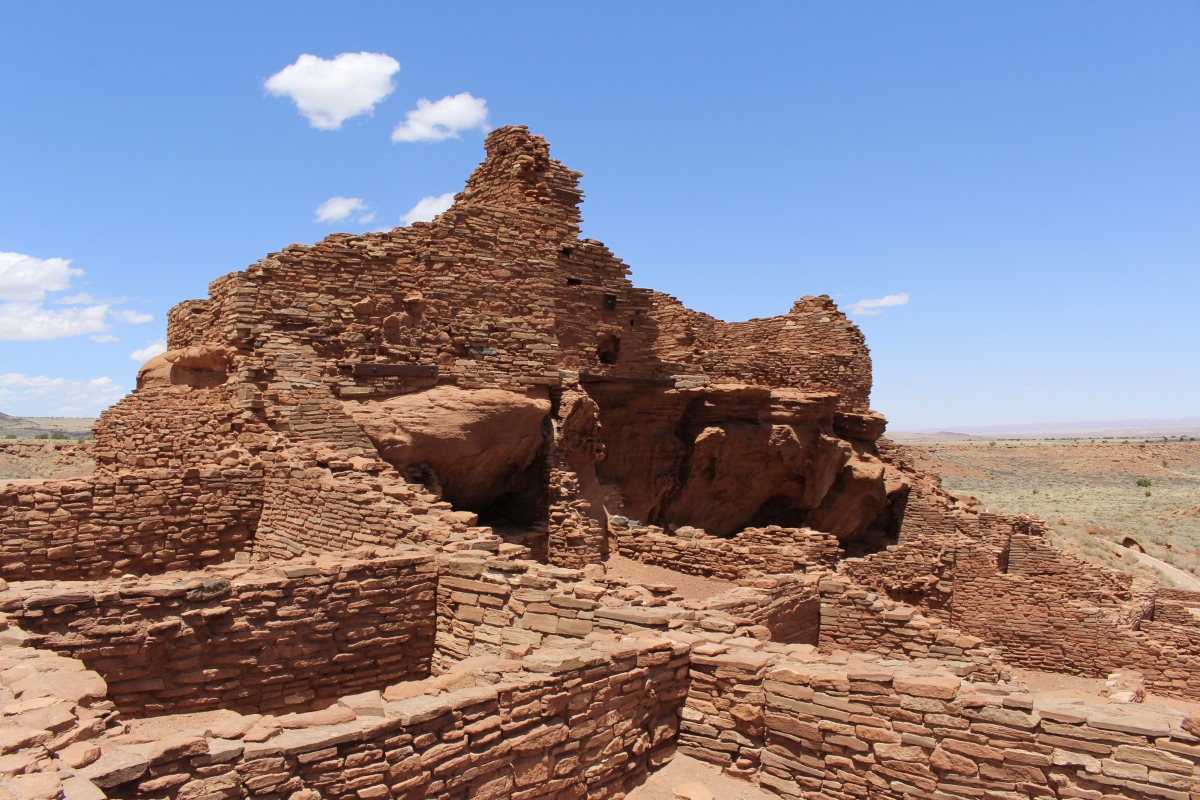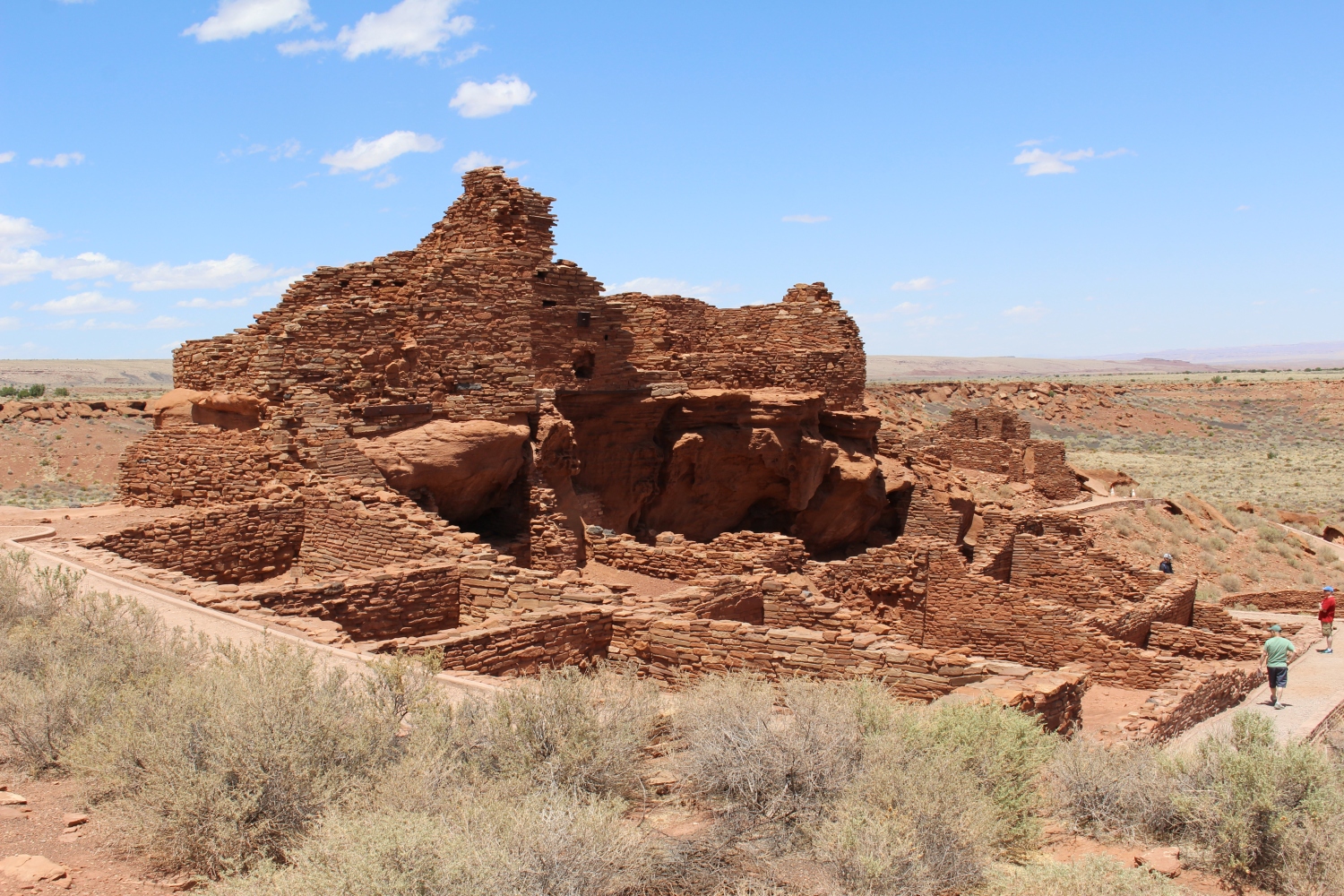Near the Visitor’s Center at Wupatki National Monument sits the amazing Wupatki Pueblo, a multi-level high rise. People gathered here during the 1100s, gradually building this 100-room pueblo with a community room and ballcourt. It was the largest dwelling for at least fifty miles. By 1182, perhaps 85 to 100 people lived here. Within a day’s walk, a population of several thousand surrounded Wupatki.
This particular village became the heart of a thriving community and was a landmark, a gathering place, and a ceremonial center. This monumental structure may have signaled control over farm lands and united a community that changed as it grew and accepted immigrants.
We walk a half-mile loop around the pueblo.

Wupatki Pueblo
Puebloan and Navajo peoples have a long list of medicinal uses for this profuse native plant, broom snakeweed, from cures for colds, stomachaches, and eye problems to rattlesnake bites. But it might not have been readily available to their ancestors. Scientists have not yet found this plant in archeological settings.

Broom Snakeweed
Many people lived in numerous small dwellings found for miles around; those living here may have held ritual and leadership responsibilities.

Wupatki Pueblo
Descendants say prophesy and beliefs guided decisions and that villages like this were purposefully settled and left. When clans departed, doorways were sealed and items left in rooms; maybe people hoped to return one day.

Community room at Wupatki Pueblo
Below is a depiction of Pueblo life here 900 years ago, based on historical accounts and archeological evidence. This embellished interpretation helps us visualize the vibrant Wupatki society. Hopi and Zuni oral histories say that people of diverse origins came together here. Plain red-brown pottery originated near Flagstaff, while the painted black and white pots came from Kayenta country to the northeast. The architecture is both Chacoan and Kayenta in style, and the ballcourt and abundant shell jewelry indicate ties to the far south.
Through trade, villagers acquired numerous Mesoamerican scarlet macaws and copper bells needed for ceremonies and rituals. Perhaps in return, they offered their woven cotton textiles, with various styles and decorative techniques from all over the Southwest. Life here involved sharing and trading.

Life in the past
Wupatki today appears abandoned, but it is actually remembered and cared for. Though it is no longer physically occupied, Hopi believe the people who lived and died here remain as spiritual guardians. Stories of Wupatki are passed on among Hopi, Zuni, Navajo, and perhaps other tribes. Members of the Hopi Bear, Sand, Lizard, Rattlesnake, Water, Snow, and Katsina Clans return periodically to deepen their personal understanding of their clan history.

Wupatki Pueblo

Wupatki Pueblo
Villagers shared walls, water, food, protection, and prayer. They depended on one another, celebrated life and marked passages, planned for, reacted, and adapted to environmental and social circumstances. People gathered to celebrate harvest and honor their way of life. Women prepared food and men and boys engaged in contests in the ballcourt. Ceremonies and rituals established harmony and encouraged rain and fertility.

Community room

Wupatki Pueblo

from the Community Room looking up at Wupatki Pueblo

Community Room & Wupatki Pueblo

Ballcourt
It is remarkable that this land, so dry and hot, supported a large farming community. Moisture-conserving cinders from the eruption of nearby Sunset Crater volcano made for slightly better farming conditions during the 1100s. But extensive land and labor would have been required.

the surrounding land
Located at the crossroads between Sinagua, Cohonina, and Kayenta Anasazi cultural traditions, Wupatki exhibits a unique cultural brew. The exchange of ideas shows up in homes built the Anasazi way but furnished with Sinagua-style pottery, textiles, and tools. Archeologists still debate whether this represents different cultures interacting here, or if it is just the “many different ways to be Sinagua.”

masonry at Wupatki Pueblo
The environment provided materials ideal for the construction of freestanding masonry dwellings. Sandstone slabs, limestone blocks, and chunks of basalt set with a clay-based mortar yielded sturdy buildings that, despite weathering and vandalism, remain partially intact more than 700 years after their owners departed.
This high desert area is home to lizards and gopher snakes, which are non-venomous and feed on rodents that live around the dwellings. Mike was disappointed to have missed out on snake encounters in these desert areas.

lizard friend

Wupatki Pueblo
The reasons people left were likely varied. By the 1200s, the area was denuded of trees and shrubs and soils were depleted. As the environment changed, perhaps conflicts increased or trade networks shifted and other villages had more to offer.
Descendants of these inhabitants, the Hopi, Zuni, and other Pueblo groups, still adhere to a lifestyle that values hard work and spiritual life over material possessions.
Of course, at the Visitor’s Center, I got my sticker and cancellation stamp!

Wupatki National Monument sticker and Passport stamp
*Sunday, May 13, 2018*
***********************
On Sundays, I plan to post various walks that I took on our Four Corners trip as well as hikes I take locally while training for the Camino de Santiago; I may also post on other unrelated subjects. I will use these posts to participate in Jo’s Monday Walks or any other challenges that catch my fancy.
This post is in response to Jo’s Monday Walk.





Such an arid landscape – it’s hard to imagine anyone ever living here.
LikeLike
It really is!
LikeLike
I love the sense of community, Cathy. We don’t find that so much any more but in that environment it would be crucial. 😃 Thanks for sharing, hon. I shall do a round up of walks at some point. Sending hugs! Last week of Camino coming up xx
LikeLike
I love the community too, Jo. I believe it was essential in that harsh environment. Yes! Today is my last day of walking!
LikeLike
Woo Hoo! So proud of you, hon 🙂 🙂 xx
LikeLiked by 1 person
Thank you, Jo!! 😍
LikeLiked by 1 person
When I see places like this, I want to know so much more. What did they wear, eat and drink, sit on, sleep on? And medicines particularly, they must have learnt which plants had healing properties.
LikeLike
I’ve written a number of posts about plants they used for household and medicinal purposes, Gilly. As for the rest, it’s way too much for me to write in a blog post so I guess you’ll have to visit! 😊
LikeLike
A fascinating read and insight into a people and history that I know nothing of.
LikeLike
Thank you, Richard. I learned a lot from visiting this area!
LikeLiked by 1 person
An amazing place.
LikeLiked by 1 person
The photos and the writing are fantastic! I know so much more about the place, the people, and the past. I’m glad the lizard is a friend.
LikeLike
Thank you so much. It was a fascinating place to visit. And I love lizards 🦎. Always friends! 😊
LikeLike
I remember this place – fascinating. Hope all is still going well.
LikeLike
All is going well, Anabel. I have one more day of walking: 20 km to Santiago. Then I can finally rest!
LikeLike
Excellent, best wishes for a splendid finish!
LikeLike
I finished yesterday and just got my Compostela this morning!
LikeLike
Congratulations!
LikeLike
Thank you, Anabel! What will I do now that I don’t have to walk every day? 😊
LikeLike
I’m sure you’ll think of something!
LikeLike
These three parks around Flagstaff were such a pleasant surprise. They weren’t crowded, were easy to get around,had great historical significance and were fun places to explore.
LikeLike
Agreed. And to think they weren’t even on our itinerary.
LikeLike
[…] Wupatki Pueblo […]
LikeLike